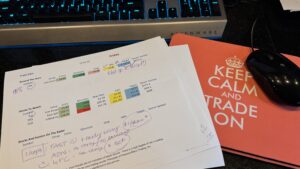Trade Management for Day Traders is at the heart of successful trading. As traders, we’re not just reacting to the market; we’re following a carefully crafted plan that keeps us disciplined, focused, and in control. But achieving that discipline takes more than just willpower. It’s about setting up a structured approach to managing trades that includes establishing levels for exits, using software tools to automate where we can, and keeping emotions out of the picture. If you’ve been guilty of over-trading, pulling profits too early, or abandoning your strategy mid-trade, then it’s time to revisit the importance of proper trade management for day traders.
1. Planning Exits Before Entering the Trade for Expert Trade Management
One of the most critical aspects of disciplined trade management is having a clear exit strategy before you even consider hitting that “buy” or “sell” button. This is non-negotiable. When you define your exit levels in advance, you’re building a framework to protect yourself from emotional decisions.
Each trade should have two essential components:
- Primary Exit Levels: Where will you take profits if the trade goes your way?
- Stop-Loss Levels: Where will you cut your losses if the trade moves against you?
Without these levels clearly defined in advance, trades can quickly turn into emotional roller coasters. Setting your exit levels in advance not only keeps your risk in check but also removes the uncertainty of decision-making in the heat of the moment.
At Traderinsight, we have these levels defined for all of our trades, but the most straightforward is Adrian’s intraday trading plan called Around the Horn with all levels clearly defined. Click Here to view these plans over the next two weeks: www.Traderinsight.com/trade.
2. Moving Exits to Breakeven with Trade Management: When and Why
In addition to setting profit and stop-loss levels, for the best trade management for day traders I advocate for a strategy that includes moving exits to break even at certain predefined points. The breakeven point—where its full potential. By moving your stop-loss to breakeven at a specific point, you lock in a safety margin without risking your initial capital. This technique can help prevent small wins from turning into losses and keeps you mentally prepared for the next opportunity.
The key to this approach is defining when you’ll move your exit to breakeven. This could be based on specific price movements, a percentage gain, or a technical indicator that signals the trade is progressing as expected. Having this rule in place removes the guesswork and lets you focus on executing your strategy with discipline, not emotions.
3. Harnessing the Power of Software Automation to Manage Day Trades
Even the best-laid trading plans can be challenging to follow in the fast-paced world of trading. That’s where automation comes in. Software tools can be used to set and adjust your exit levels automatically, helping you stay disciplined without needing to constantly monitor the screen.
For instance, you can configure trading software to:
- Set your profit and stop-loss levels immediately upon entering a trade.
- Automatically move your stop-loss to breakeven once a certain price level is hit.
- Exit the trade if it reaches your predetermined profit level or stop-loss without any manual intervention.
Automation like this is a game-changer. It prevents hesitation, overtrading, and impulse decisions that can come from watching the market too closely. With your exit rules automated, you can focus on analyzing your next setup instead of worrying about whether you’ll stick to your plan.
4. Entering and Exiting Based on a Rules-Driven Strategy Makes Managing Trades Easy
Many traders fall into the trap of taking trades based on gut feeling, news hype, or spur-of-the-moment impulses. But successful trading isn’t about “winging it.” It’s about executing a strategy with rules for both entries and exits. Your trade management should be as structured as your entry setup.
When you enter a trade with specific rules in mind, you’re essentially telling yourself, “This is how I will handle this trade, no matter what the market throws at me.” Rules-based trading removes emotional decision-making from the equation and helps you focus on your plan rather than reacting to price fluctuations.
In my experience, the best strategies are simple and easy to replicate. They include clear, step-by-step criteria for both entering and exiting trades. Once you’ve established these rules, the goal is to follow them to the letter without deviating or second-guessing yourself.
5. Good Trade Management Starts at the Planning Phase
Effective trade management isn’t something you figure out mid-trade; it starts long before you enter the market. In the planning phase, you should:
- Identify potential entry points and define the conditions under which you’ll enter the trade.
- Establish clear exit levels for taking profits and stopping losses.
- Plan when and how you’ll adjust your stop-loss to break even.
- Set up your automation tools to support these rules.
This initial planning ensures that every aspect of the trade is accounted for before you even begin. Not only does this make trading less stressful, but it also gives you the confidence that you’re prepared for any scenario.
6. Keeping Emotions Out of the Trade
Once your trade is underway, it’s natural to feel a range of emotions—excitement, anxiety, and even fear. But the true measure of a disciplined trader is the ability to stick to the plan despite these emotions. This is where proper trade management and automation work hand-in-hand to keep you on track.
With automation, you don’t need to worry about adjusting your stop-loss or exiting prematurely based on a fleeting emotion. You’ve set your exit rules in advance, and your software will execute those rules for you. This approach helps prevent over-trading, chasing losses, or closing out a winning trade too early.
When you let emotions control your trading, you’re essentially giving up control over the outcome. By sticking to a structured, rules-based approach with pre-defined exit levels and automation, you’re ensuring that your trades are managed objectively rather than emotionally.
In Summary
Proper trade management is the foundation of disciplined trading. By setting exit levels before you enter, planning when to move your stop-loss to breakeven, and utilizing automation tools, you can trade confidently and consistently. These steps not only protect your capital but also allow you to stay in the market long enough to build sustainable success.
If you’re serious about elevating your trading game, I encourage you to embrace this structured, disciplined approach for trade management for day traders. With the right plan, tools, and mindset, you can manage trades effectively and avoid the pitfalls of emotional decision-making. And remember: good trade management starts before you enter the trade and continues all the way to the exit. This commitment to discipline is what turns day trading from a gamble into a strategy-driven pursuit of long-term success.


